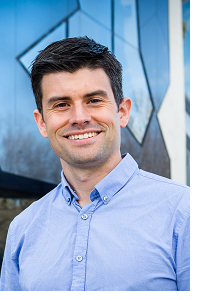




COLIN JACKSON


colin.jackson@anu.edu.au





Engineering new proteins to degrade nerve agents
Abstract
Organophosphate nerve agents comprise classes of both pesticides and chemical warfare agents owing to their ability to irreversibly inhibit acetylcholiesterase in the central and peripheral nervous systems. Current treatment of poisoned individuals is relatively ineffective, and high mortality rates are frequently reported. The development of insecticide resistance in the Australian sheep blowfly, Lucilia cuprina, offers a potential solution to this problem. The alpha E7 carboxylesterase has evolved within the fly to break down and detoxify organophosphates. In this presentation I will discuss our recent attempts to engineer the alpha E7 carboxylesterase, which has allowed us to alter its oligomeric structure and increase its stability and catalytic efficiency. Our engineered version of the protein is now the highest affinity catalytic bioscavenger for organophosphates reported to date, and a viable candidate as a potential biotherapeutic in cases of organophosphate poisoning.
2014-: ARC Future Fellow, Research School of Chemistry, Australian National University.
2011-2014: Senior Lecturer, Research School of Chemistry, Australian National University.
2009-2011: Marie Curie Fellow, Institut de Biologie Structurale, Grenoble, France.
2007-2009: Team Leader, Commonwealth Scientific and Industrial Research Organization.
2007: PhD, Australian National University, ACT, Australia.
Research Fields and Interests:
We are interested in understanding how proteins, especially enzymes, function and evolve, particularly with regard to the role of “structural dynamics” or movement. To do this, we use a range of techniques, from protein crystallography, to directed evolution, to fluorescence spectroscopy. The knowledge that we gain from these fundamental studies can then be used in an applied sense: we are undertaking engineering projects focusing on the construction of biosensors for neurotransmitters, as well as bio-therapeutics to treat individuals that have been poisoned by chemical warfare agents.
Selected Publications:
Kaltenbach M, Jackson CJ, Campbell E, Hollfelder F, Tokuriki N (2015) Reverse evolution leads to molecular speciation despite functional and active-site convergence. E-life. e06492
Whitfield JH, Zhang W, Herde MK, Clifton BE, Radziejewski J, Janovjak H, Henneberger C, Jackson CJ (2015) Construction of a robust and sensitive arginine biosensor through ancestral protein reconstruction. Protein Sci. 24 (9), 1412-1422
Tokuriki N, Jackson CJ (2014) Enzyme Dynamics and Engineering: One Step at a Time. Chem & Biol. 21 (10), 1259-1260.
Jackson CJ, Liu JW, Carr PD, Younus F, Coppin C, Meirelles T, Lethier M, Pandey G, Ollis DL, Russell RJ, Weik M, Oakeshott JG. (2013) Structure and function of an insect α-carboxylesterase (αEsterase7) associated with insecticide resistance. Proc Natl Acad Sci U S A. 110(25):10177-82.
Tokuriki N, Jackson CJ, Afriat-Jurnou L, Wyganowski KT, Tang R, Tawfik DS. (2012) Diminishing returns and tradeoffs constrain the laboratory optimization of an enzyme. Nat Commun. 3:1257.